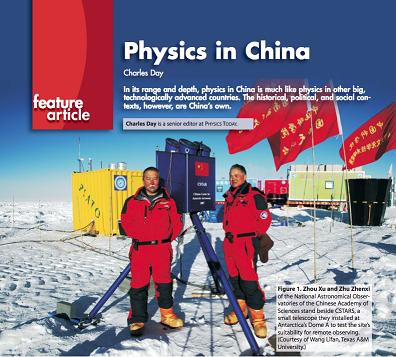Charles Day, senior editor at "Physics Today", made a special report about China's recent rise in physics in the March 2010 issue of the journal. He said "In its range and depth, physics in China is much like physics in other big, technologically advanced countries. The historical, political, and social contexts, however, are China's own." In the section about international collaboration, Mr. Day illustrated in astronomy how China align the country's international collaborations with national interests. National Astronomical Observatories of Chinese Academy of Science (NAOC) play key role in the three international collaboration projects presented in the article.
 "China’s efforts in astronomy illustrate how the country’s international collaborations align with national interests. China currently lacks the experience to build observatories at the leading edge of technology, such as the European Space Agency’s recently launched IR satellite, Herschel. Acquiring that experience through independent effort would take time and risk China’s falling further behind. To catch up, China is pursuing a mix of more modest, home-grown advances and participation in international projects.
China’s recently commissioned LAMOST telescope will survey the sky in a fashion similar to that of the Sloan Digital Sky Survey—that is, it will automatically determine the spec- tra (and therefore redshifts) of the stars and galaxies over large swaths of sky. LAMOST’s primary mirror has four times the area of the SDSS telescope’s, and its focal-plane CCDs are more efficient and more sensitive. LAMOST’s performance is limited somewhat by the modest number of truly clear nights at its site in Hebei Province. Still, it’s expected to produce the most complete catalog of stellar motions in our galaxy and with it the most accurate map so far of the Milky Way’s dis- tribution of gravitational matter, both baryonic and dark.
The LAMOST telescope has provided China with valu- able experience in the production and operation of seg- mented mirrors. As this article goes to press, China is nego- tiating the terms of its participation in the Thirty Meter Telescope, a US–Canadian project to build a huge segmented- mirror observatory on Mauna Kea in Hawaii. In the TMT, China will play a minority role. But in the case of the proposed observatory at Dome A, China will lead. As figure 1 shows, site characterization is already under way. The challenges of observing remotely in the Antarctic are for- midable. Power needs to be generated locally, and data have to be retrieved across shifting, breaking ice sheets. In taking up those challenges, China has the field largely to itself.
China is also determined to become a hospitable and profitable place for international visitors. Two examples il- lustrate that trend. Zhejiang University and Rice University in Houston, Texas, have set up the International Collabora- tive Center on Quantum Matter. The London Center for Nanotechnology and the Max Planck Institute for the Physics of Complex Systems in Dresden, Germany, also par- ticipate. The idea is to foster collaboration on projects of mu- tual interest through workshops and long visits. At Peking University, the two-year-old KIAA also conducts interna- tional workshops (see figure 4). Doug Lin, its founding director, says the institute will serve as a place where West- ern and Chinese researchers can collaborate and learn from each other.
Unfortunately, China’s desire to forge partnerships with the US is being frustrated by US immigration policy. The pro- cedure a Chinese physicist must follow for obtaining a US visa is burdensome, time consuming, and uncertain—to the point that many Chinese physicists have given up trying to visit the US. Obtaining a US visa can take three months. By stark contrast, Chinese physicists can obtain an EU visa within four business days without having to apply in person. US visitors to China can obtain a visa in one day."(from charles Day's Physics in China, Physics Today March 2010)
|













